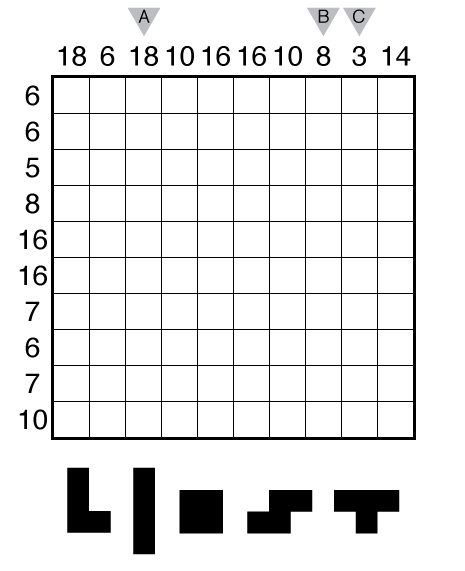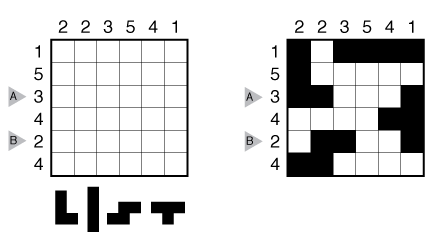Place by Product by Ravi Kumar Macherla

or solve online (using our beta test of Penpa-Edit tools).
Theme: Logical
Author/Opus: This is the 1st puzzle from guest contributor Ravi Kumar Macherla who also contributed several Masyu to the book “The Art of Puzzles”. You can find more of Ravi’s puzzles on his relatively new blog site.
Rules: Place each of the indicated shapes into the grid (rotations allowed, but not reflections) so that no two shapes touch even at a corner. Numbers outside the grid indicate the product of the lengths of all white cell groups in that row/column. Or see here:

Answer String: Enter the number of cells in each group (both black and white) in order in the marked rows/columns. In the example, this answer is “231,1221”
Time Standards (highlight to view): Grandmaster = 4:15, Master = 7:00, Expert = 14:00
Solution: PDF

07:40.
Interesting new genre. That was also pretty tough; probably because it’s the first puzzle.
My one comment on this particular puzzle is that the logical approach is somewhat narrow, and there are also some traps in how you’ll think about some clues that can be bad (our testers reported the same one I ran into at least). So I don’t think it is just a “first puzzle” effect.
I failed so hard at this puzzle. I kept thinking “rvtugrra rdhnyf guerr gvzrf fvk”, and did not consider other possibilities.
Initially I made the same error, generally “rirel ahzore zhfg vaqvpngr gur zhygvcyvpngvba bs rknpgyl GJB ahzoref”…
Very nice new puzzle type !
THANK YOU!
Failed 3 time in a row. going to try again now…
Honestly, this was rather straightforward and had a complete logical path that didn’t even require use of the “not reflections” rule. All you had to do was keep your whites and blacks straight, and not eliminate any possibilities, in the same way you keep open-minded with TomTom and Cross the Streams.
Perhaps the trap was rushes to judgment. In particular, the O tile was subject to a potential rush to judgment when the solver should remain open-minded until the answer is logically determined.
However, there are the risks of overspecification and of hyperaccounting inherent in the type. Perhaps it might be improved by deleting some of the numbers and/or some of the piece information in #2 (starting with allowing reflections, e.g.).
I believe, given the no-reflections rule, that the example puzzle can be solved with only the following data: rows, 15????; columns, ???5?1.
Ravi’s already shown me some puzzles with missing clues but for a first puzzle it seemed fine to overspecify. You’ll probably catch more on his blog eventually.
I do think one difference in the solving perspective you are sharing and that of other solvers is that many people are trying to solve as fast as they can. This is a style where learning by intuition can be as effective or more effective than logic in my experience if time is the goal. But the logical path is certainly helped by not excluding possibilities too soon. In my roughly 10 data points of (test)solving comments, about half of solvers reported missing one of the product possibilities which got them in trouble.